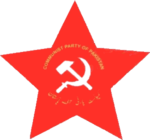Communist Party of Pakistan
The Communist Party of Pakistan (abbreviated CPP; Urdu: کمیونسٹ پارٹی آف پاکستان) is a communist party in Pakistan.
Communist Party of Pakistan کمیونسٹ پارٹی آف پاکستان | |
|---|---|
 | |
| Abbreviation | CPP |
| Chairman | Jameel Ahmad Malik |
| Founder | Sajjad Zaheer |
| Founded | 6 March 1948 |
| Split from | Communist Party of India |
| Headquarters | Central Secretariat, 1426-Fateh Jang Chowk, Attock Cantt, Pakistan |
| Ideology | Communism Marxism–Leninism |
| Political position | Left-wing |
| International affiliation | IMCWP[1] |
| Colors | Red |
| Election symbol | |
| Sickle | |
| Website | |
| http://www.cpp.net.pk | |
Founding
The CPP was founded in Calcutta, India, on March 6, 1948. A decision was taken at the Second All-India Conference of the Communist Party of India, which was held in Calcutta at that time, that a separate communist party ought to be created in the new state of Pakistan. It was thought that Pakistan, being a relatively small country (in comparison to India) and suffering from instability, was ripe for revolution. The delegates from Pakistan separated themselves and held a separate session where they constituted the CPP. Sajjad Zaheer (founder of the All-India Progressive Writers Association), from West Pakistan, was elected General-Secretary. The delegates from East Pakistan elected an East Pakistan Provincial Committee. Many Muslim leaders of the CPI were sent to Pakistan to help with the formation of the party.
Goals
The attempt to start a revolution in Pakistan failed and the CPP leaders were jailed. In the 1951 Rawalpindi Conspiracy Case, many leading members were convicted and the party was forcibly repressed by successive governments.
Struggles
Diplomatic intervention by Jawaharlal Nehru led to the most prominent CPP leaders being freed and sent back to India. At this stage the CPP was in poor shape in West Pakistan, while in East Pakistan the party had a limited foundation. However, it was difficult to have a unified underground political organization spanning such a vast geographical territory and the East Pakistan branch was able to operate with autonomy.
1950s
In the provincial elections in East Pakistan in 1954, the CPP supported the United Front launched by the Awami League, Krishak Praja Party and the Nizam-e-Islam party. Four out of ten CPP candidates were elected, and 23 CPP members were elected as candidates of other parties.
In 1954 the party and its front organizations such as the National Students Federation, Progressive Writers' Movement and Railway Workers' Union were banned. As a result, the CPP launched the Azad Pakistan Party (APP) in West Pakistan with Mian Iftikhar-ud-Din as leader. In 1957, the CPP and other leftists created the National Awami Party as a legal party. The APP merged into the NAP.
In East Pakistan, the CPP worked within the Awami League and then in Ganatantri Dal. In 1958 the Kull Pakistan Kissan Association (All Pakistan Peasants Association) was launched.
1960s
In the mid-1960s the US State Department estimated the party membership to be approximately 3000.[2] The CPP also began to organize themselves abroad. In Europe, the CPP branch published the Urdu magazine Baghawat, which translates as "rebellion".
In 1966 the Sino-Soviet split reached the CPP. In East Pakistan a pro-Chinese group broke away from the CPP. At the fourth party congress in Dhaka in 1968, a decision was taken that a separate communist party should be formed for East Pakistan. Thus the Communist Party of East Pakistan (CPEP) was founded. The CPEP later became the Communist Party of Bangladesh.
The CPP organized a militant and armed peasants struggle in Patfeeder, Baluchistan. The CPP resisted the autocratic regimes of the times, and built up militant trade union movements.
1990s
In December 1990 Jam Saqi became general secretary of the party. In April 1991, he resigned from the party.[3] In 1995 the CPP merged with the Major Ishaque faction of the Mazdoor Kissan Party to form the Communist Mazdoor Kissan Party (CMKP). The CPP accepted the criticism that they had been too uncritical towards the Soviet Union. However, in 1999 a group broke away from the CMKP and reconstituted the CPP. In 2002, the CPP split, leading to the existence of two separate CPPs, one led by Maula Bux Khaskheli and a splinter group led by Khadim Thaheem.
2013
The Communist Party of Pakistan (CPP) was registered under the Article 17 of the Constitution of Pakistan, 1973 since decades after when the CPP was banned in July 1954 on charges of plotting to overthrow then government and crackdown against its leadership throughout the country.
According to latest information, the party is not currently registered as a political party in Pakistan by the Election Commission of Pakistan. [4]
References
- IMCWP. "Participants List". IMCWP. Retrieved 16 February 2019.CS1 maint: uses authors parameter (link)
- Benjamin, Roger W.; Kautsky, John H. (March 1968). "Communism and Economic Development". 62 (1). American Political Science Association: 122. JSTOR 1953329. Cite journal requires
|journal=(help) - "Jam Saqi interview". Pakistan Christian Post. Archived from the original on 2013-04-26. Retrieved 2008-07-04.
- "ECP - Election Commission of Pakistan". www.ecp.gov.pk. Retrieved 2020-07-24.

